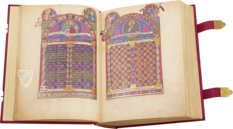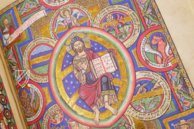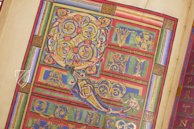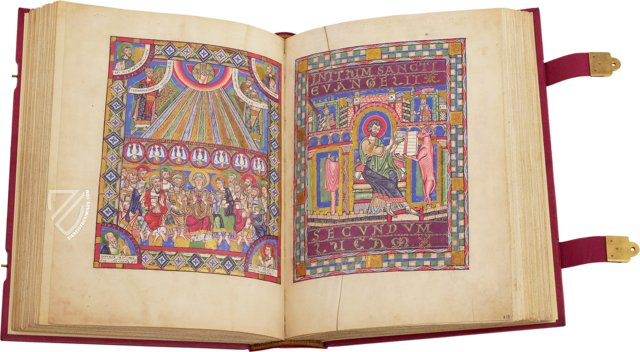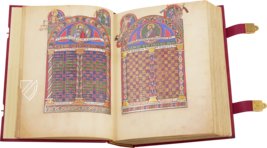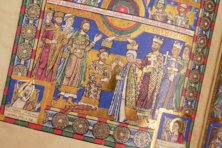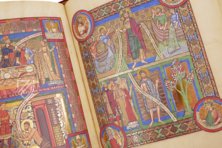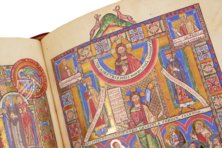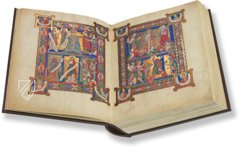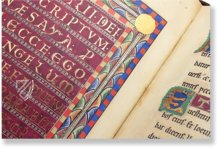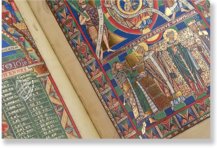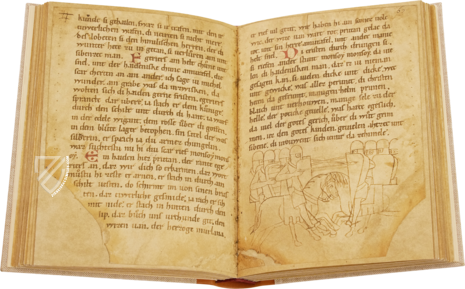Gospels of Henry the Lion
(3,000€ - 7,000€)
The Gospels of Henry the Lion is considered the greatest masterpiece of Romanesque book illumination in northern Germany. As one of the most magnificent and richly decorated illuminated manuscripts of the Middle Ages, it remains exceptional to this day. It was commissioned by Duke Henry between 1175 and 1188 and produced by the monks of the Benedictine Abbey of Helmarshausen. The religious duke was one of the richest and most powerful men of the 12th century and a great patron of the arts and literature. The 452-page manuscript is richly illuminated with masterful miniatures in bold colours and gleaming gold leaf. These are complemented by countless artistically designed initials, large and small, so that the beautiful Gospels have been admired for centuries for their astonishing ornamentation. In addition to the four Gospels, the manuscript contains the story of the salvation of Christianity in moving miniatures, which offer the viewer an insight into the religious world of the Gothic rulers.
The Gospels of Henry the Lion
One of the most magnificent and most elaborately decorated books of the Middle Ages originated from approximately between 1175 and 1188 from the German Benedictine abbey of Helmarshausen. Duke Henry the Lion commissioned the literate monks of the abbey to create a evangeliary for Mary’s altar in St. Blaise’s parish church in Brunswick. This beautiful work is the main piece of the Romanesque illumination of the 12th century in northern Germany. The evangeliary contains the four gospels and reveals the history of Christianity in moving miniatures. Overall, the manuscript is 226 pages long with fifty full page miniatures, seventeen canon boards, four pictures of the evangelists, nine ornamental pages and twenty portrayals. The entire text includes approximately 1,500 small, 77 big, and seven large richly decorated initials.
On Commission of the Duke
Henry the Lion was one of the greatest rulers from the House of Guelph. Between 1142 and 1180 he was the Duke of Saxony as well as the Duke of Bavaria from 1156 to 1180. The foundation of today’s state capital Munich can be traced back to Henry. In his role as Duke of Saxony he had decisive part in the coronation of his cousin Fredrick Barbarossa. They had a good political relationship with each other until they fell out in 1176. The duke refused to pledge his military support to the king. This means that Henry has been seen for a long time as the most important protagonist of the Staufer-Guelph opposition. The religious duke was one of the richest and most powerful men of the twelfth century and was regarded as a great patron of art and literature. Among his numerous donations of liturgical manuscripts to churches and monasteries, the evangeliary for St. Blaise’s church is the most distinguished and most famous.
A Dramatic History
The much detailed but still unexplained history of the manuscript leads from Brunswick to Prague, where it lay for hundreds of years in the library of St. Vitus’ Cathedral. In 1861, the manuscript succeeded to be recovered on the order of King George V through Hannover from Prague to Lower Saxony. In 1866 however, it went with the then powerless Guelphs in exile to Austria. From 1933 to 1983 the whereabouts of the manuscript was unknown. It first returned to public view at auction in London in 1983. Since then, the interest in the manuscript has been unbroken. One of the creators of the work has signed the book at the front with: liber labor est Herimanni – Monk Hermann made this book.
Fantastic Picture Decorations
The spellbinding evangeliary has impressed readers for many hundreds of years with its amazing book decorations. The numerous valuable pictures show a wide range of intense colors and are abundantly adorned with gold. The hand-painted scenes, which engage every reader, belong among the highest-quality illuminations of the Middle Ages. As well as depictions of Christian history there are also scenes that are dedicated to the customer of the valuable manuscript. One especially nice hand-painted full-page image depicts the coronation scene of Henry and his wife Mathilda, a daughter of King Henry II of England. Another scene shows the reigning couple being guided to an enthroned Maria and Henry offering her the evangeliary. The moving images enable their audience to dream and invite them on a journey into the spiritual world of the greatest rulers of gothic times.
Codicology
- Alternative Titles
- Evangeliar Heinrichs des Löwen
Evangeliarium Heinrici Leonis - Size / Format
- 532 pages / 34.0 × 25.5 cm
- Origin
- Germany
- Date
- Around 1175–1188
- Epochs
- Style
- Genre
- Language
- Illustrations
- 50 full-page miniatures, 84 large and approx. 1500 smaller initials
- Patron
- Henry the Lion, Duke of Saxony and Bavaria (reigned 1142–1180) and his consort Matilda, daughter of King Henry II of England (reigned 1154–1189)
- Artist / School
- Herimann
- Previous Owners
- Emperor Charles IV (1347–1378)
King George V of Hanover (reigned 1819–1878)
Guelph family
Gospels of Henry the Lion
Christ in Majesty
The so-called Maiestas Domini is one of the most popular images in Western Christian art. Modelled on depictions of the Roman emperor, Christ is always depicted enthroned and framed by a mandorla. Meaning “almond” in Italian, a mandorla is an almond-shaped frame in which Christ is presented, usually surrounded by other religious figures or icons. Christ is depicted before a blue sky full of stars, seated on the lower band of the mandorla while resting his back against the upper band.

Gospels of Henry the Lion
Dedication image
In the lower register, Henry the Lion and his wife Matilda of England are led to an enthroned Virgin Mary in the upper register by the saints Blasius and Aegidius. Henry offers the manuscript at hand to the Queen of Heaven, flanked by John the Baptist and St. Bartholomew. This masterpiece was created by the monks of Helmershausen Abbey at Henry’s behest as a gift to Brunswick Cathedral, dedicated to St. Blaise, to celebrate the consecration of a new altar in honor of the Virgin Mary.
This page, aside from being informative, is an exemplary specimen of the late-Romanesque art found in this splendid manuscript. It is distinguished by its intense opaque primary colors, which are highlighted with expertly applied gold and silver, especially the filigreed backgrounds.

#1 Evangeliar Heinrichs des Löwen (Leather Edition)
Language: German
(3,000€ - 7,000€)
#2 Evangeliar Heinrichs des Löwen
Language: German
(3,000€ - 7,000€)
#3 Das Evangeliar Heinrichs des Löwen (Collection)
Language: German
- Treatises / Secular Books
- Apocalypses / Beatus
- Astronomy / Astrology
- Bestiaries
- Bibles / Gospels
- Chronicles / History / Law
- Geography / Maps
- Saints' Lives
- Islam / Oriental
- Judaism / Hebrew
- Single Leaf Collections
- Leonardo da Vinci
- Literature / Poetry
- Liturgical Manuscripts
- Medicine / Botany / Alchemy
- Music
- Mythology / Prophecies
- Psalters
- Other Religious Books
- Games / Hunting
- Private Devotion Books
- Other Genres
- Afghanistan
- Armenia
- Austria
- Belgium
- Belize
- Bosnia and Herzegovina
- China
- Colombia
- Costa Rica
- Croatia
- Cyprus
- Czech Republic
- Denmark
- Egypt
- El Salvador
- Ethiopia
- France
- Germany
- Greece
- Guatemala
- Honduras
- Hungary
- India
- Iran
- Iraq
- Israel
- Italy
- Japan
- Jordan
- Kazakhstan
- Kyrgyzstan
- Lebanon
- Liechtenstein
- Luxembourg
- Mexico
- Morocco
- Netherlands
- Palestine
- Panama
- Peru
- Poland
- Portugal
- Romania
- Russia
- Serbia
- Spain
- Sri Lanka
- Sweden
- Switzerland
- Syria
- Tajikistan
- Turkey
- Turkmenistan
- Ukraine
- United Kingdom
- United States
- Uzbekistan
- Vatican City
- A. Oosthoek, van Holkema & Warendorf
- Aboca Museum
- Ajuntament de Valencia
- Akademie Verlag
- Akademische Druck- u. Verlagsanstalt (ADEVA)
- Aldo Ausilio Editore - Bottega d’Erasmo
- Alecto Historical Editions
- Alkuin Verlag
- Almqvist & Wiksell
- Amilcare Pizzi
- Andreas & Andreas Verlagsbuchhandlung
- Archa 90
- Archiv Verlag
- Archivi Edizioni
- Arnold Verlag
- ARS
- Ars Magna
- ArtCodex
- AyN Ediciones
- Azimuth Editions
- Badenia Verlag
- Bärenreiter-Verlag
- Belser Verlag
- Belser Verlag / WK Wertkontor
- Benziger Verlag
- Bernardinum Wydawnictwo
- BiblioGemma
- Biblioteca Apostolica Vaticana (Vaticanstadt, Vaticanstadt)
- Bibliotheca Palatina Faksimile Verlag
- Bibliotheca Rara
- Boydell & Brewer
- Bramante Edizioni
- Bredius Genootschap
- Brepols Publishers
- British Library
- C. Weckesser
- Caixa Catalunya
- Canesi
- CAPSA, Ars Scriptoria
- Caratzas Brothers, Publishers
- Carus Verlag
- Casamassima Libri
- Centrum Cartographie Verlag GmbH
- Chavane Verlag
- Christian Brandstätter Verlag
- Circulo Cientifico
- Club Bibliófilo Versol
- Club du Livre
- CM Editores
- Collegium Graphicum
- Collezione Apocrifa Da Vinci
- Comissão Nacional para as Comemorações dos Descobrimentos Portugueses
- Coron Verlag
- Corvina
- CTHS
- D. S. Brewer
- Damon
- De Agostini/UTET
- De Nederlandsche Boekhandel
- De Schutter
- Deuschle & Stemmle
- Deutscher Verlag für Kunstwissenschaft
- DIAMM
- Droz
- E. Schreiber Graphische Kunstanstalten
- Ediciones Boreal
- Ediciones Grial
- Ediclube
- Edições Inapa
- Edilan
- Editalia
- Edition Deuschle
- Edition Georg Popp
- Edition Leipzig
- Edition Libri Illustri
- Editiones Reales Sitios S. L.
- Éditions de l'Oiseau Lyre
- Editions Medicina Rara
- Editorial Casariego
- Editorial Mintzoa
- Editrice Antenore
- Editrice Velar
- Edizioni Edison
- Egeria, S.L.
- Eikon Editores
- Electa
- Emery Walker Limited
- Enciclopèdia Catalana
- Eos-Verlag
- Ephesus Publishing
- Ernst Battenberg
- Eugrammia Press
- Extraordinary Editions
- Fackelverlag
- Facsimila Art & Edition
- Facsimile Editions Ltd.
- Facsimilia Art & Edition Ebert KG
- Faksimile Verlag
- Feuermann Verlag
- Folger Shakespeare Library
- Franco Cosimo Panini Editore
- Friedrich Wittig Verlag
- Fundación Hullera Vasco-Leonesa
- G. Braziller
- Gabriele Mazzotta Editore
- Gebr. Mann Verlag
- Gesellschaft für graphische Industrie
- Getty Research Institute
- Giovanni Domenico de Rossi
- Giunti Editore
- Graffiti
- Grafica European Center of Fine Arts
- Guido Pressler
- Guillermo Blazquez
- Gustav Kiepenheuer
- H. N. Abrams
- Harrassowitz
- Harvard University Press
- Helikon
- Hendrickson Publishers
- Henning Oppermann
- Herder Verlag
- Hes & De Graaf Publishers
- Hoepli
- Holbein-Verlag
- Houghton Library
- Hugo Schmidt Verlag
- Idion Verlag
- Il Bulino, edizioni d'arte
- ILte
- Imago
- Insel Verlag
- Insel-Verlag Anton Kippenberger
- Instituto de Estudios Altoaragoneses
- Instituto Nacional de Antropología e Historia
- Introligatornia Budnik Jerzy
- Istituto dell'Enciclopedia Italiana - Treccani
- Istituto Ellenico di Studi Bizantini e Postbizantini
- Istituto Geografico De Agostini
- Istituto Poligrafico e Zecca dello Stato
- Italarte Art Establishments
- Jan Thorbecke Verlag
- Johnson Reprint Corporation
- Josef Stocker
- Josef Stocker-Schmid
- Jugoslavija
- Karl W. Hiersemann
- Kasper Straube
- Kaydeda Ediciones
- Kindler Verlag / Coron Verlag
- Kodansha International Ltd.
- Konrad Kölbl Verlag
- Kurt Wolff Verlag
- La Liberia dello Stato
- La Linea Editrice
- La Meta Editore
- Lambert Schneider
- Landeskreditbank Baden-Württemberg
- Leo S. Olschki
- Les Incunables
- Liber Artis
- Library of Congress
- Libreria Musicale Italiana
- Lichtdruck
- Lito Immagine Editore
- Lumen Artis
- Lund Humphries
- M. Moleiro Editor
- Maison des Sciences de l'homme et de la société de Poitiers
- Manuscriptum
- Martinus Nijhoff
- Maruzen-Yushodo Co. Ltd.
- MASA
- Massada Publishers
- McGraw-Hill
- Metropolitan Museum of Art
- Militos
- Millennium Liber
- Müller & Schindler
- Nahar - Stavit
- Nahar and Steimatzky
- National Library of Wales
- Neri Pozza
- Nova Charta
- Oceanum Verlag
- Odeon
- Orbis Mediaevalis
- Orbis Pictus
- Österreichische Staatsdruckerei
- Oxford University Press
- Pageant Books
- Parzellers Buchverlag
- Patrimonio Ediciones
- Pattloch Verlag
- PIAF
- Pieper Verlag
- Plon-Nourrit et cie
- Poligrafiche Bolis
- Presses Universitaires de Strasbourg
- Prestel Verlag
- Princeton University Press
- Prisma Verlag
- Priuli & Verlucca, editori
- Pro Sport Verlag
- Propyläen Verlag
- Pytheas Books
- Quaternio Verlag Luzern
- Reales Sitios
- Recht-Verlag
- Reichert Verlag
- Reichsdruckerei
- Reprint Verlag
- Riehn & Reusch
- Roberto Vattori Editore
- Rosenkilde and Bagger
- Roxburghe Club
- Salerno Editrice
- Saltellus Press
- Sandoz
- Sarajevo Svjetlost
- Schöck ArtPrint Kft.
- Schulsinger Brothers
- Scolar Press
- Scrinium
- Scripta Maneant
- Scriptorium
- Shazar
- Siloé, arte y bibliofilia
- SISMEL - Edizioni del Galluzzo
- Sociedad Mexicana de Antropología
- Société des Bibliophiles & Iconophiles de Belgique
- Soncin Publishing
- Sorli Ediciones
- Stainer and Bell
- Studer
- Styria Verlag
- Sumptibus Pragopress
- Szegedi Tudomànyegyetem
- Taberna Libraria
- Tarshish Books
- Taschen
- Tempus Libri
- Testimonio Compañía Editorial
- Thames and Hudson
- The Clear Vue Publishing Partnership Limited
- The Facsimile Codex
- The Folio Society
- The Marquess of Normanby
- The Richard III and Yorkist History Trust
- Tip.Le.Co
- TouchArt
- TREC Publishing House
- TRI Publishing Co.
- Trident Editore
- Tuliba Collection
- Typis Regiae Officinae Polygraphicae
- Union Verlag Berlin
- Universidad de Granada
- University of California Press
- University of Chicago Press
- Urs Graf
- Vallecchi
- Van Wijnen
- VCH, Acta Humaniora
- VDI Verlag
- VEB Deutscher Verlag für Musik
- Verlag Anton Pustet / Andreas Verlag
- Verlag Bibliophile Drucke Josef Stocker
- Verlag der Münchner Drucke
- Verlag für Regionalgeschichte
- Verlag Styria
- Vicent Garcia Editores
- W. Turnowski Ltd.
- W. Turnowsky
- Waanders Printers
- Wiener Mechitharisten-Congregation (Wien, Österreich)
- Wissenschaftliche Buchgesellschaft
- Wissenschaftliche Verlagsgesellschaft
- Wydawnictwo Dolnoslaskie
- Xuntanza Editorial
- Zakład Narodowy
- Zollikofer AG








